If Weimar cinema had one film star, then it was Emil Jannings (1884-1950) for sure. He was a great actor in the silent era and won the first Oscar for Best Actor. Too bad that during the Third Reich, he worked as a board member for the Ufa propaganda machine.

German postcard by Ross Verlag, Foreign, no. 1266/2, 1927-1928. Photo: Alex Binder / Ufa.
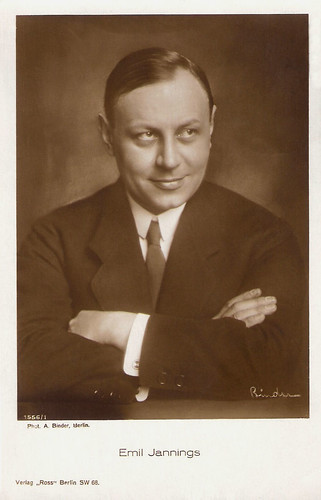
German postcard by Ross Verlag, no. 1556/1, 1927-1928. Photo: Alex Binder.
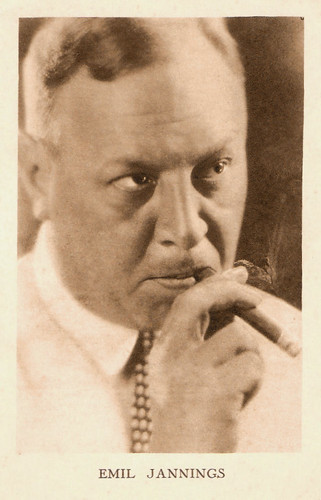
Belgian postcard by Weekblad Cinéma, Antwerpen (Antwerp).

German postcard by Film-Foto-Verlag, no. G 175, 1941-1944. Photo: Star-Foto-Atelier / Tobis.
In the Trenches
Emil Jannings was born Theodor Friedrich Emil Janenz in Rorschach, Switzerland, in 1884. He grew up in Leipzig and Görlitz. He left grammar school prematurely and worked as a ship's mate. In 1900, he started to work at the Görlitz Stadttheater, after which he played in several provincial theaters and with travelling companies. Occasionally he directed plays too. In 1914, he reached Berlin where he was engaged in 1915-1916 at Max Reinhardt's Deutsches Theater. In between, he played on stage elsewhere and had his first film role in the war propagandafilm Im Schützengraben/In the Trenches (1914, Walter Schmidthässler). Until 1920 Jannings continued to play on stage, getting bigger and bigger roles.
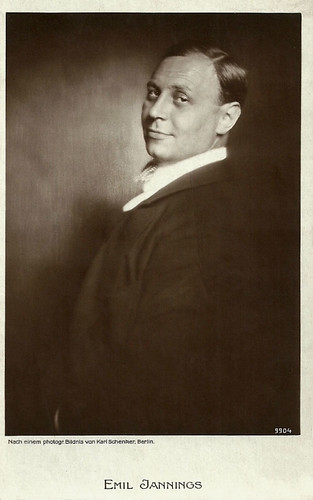
German postcard, no. 9904. Photo: Karl Schenker, Berlin.
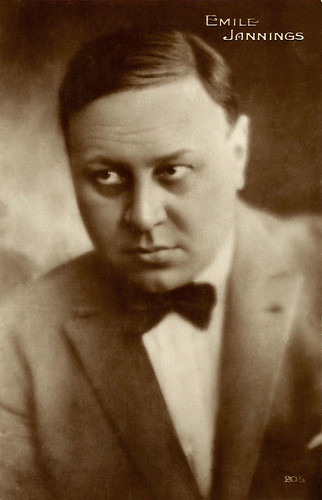
French postcard by Editions Cinémagazine, no. 205.
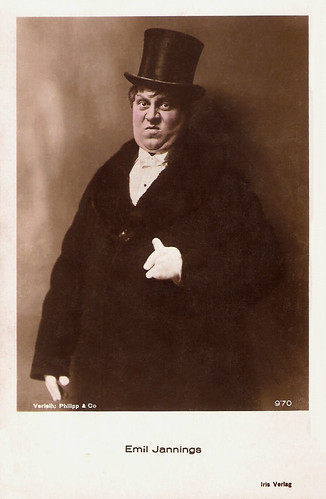
Austrian postcard by Iris Verlag, no. 970. Photo: Verleih Philipp & Co.
Ernst Lubitsch
From 1916 on, Emil Jannings played more and more in film, mostly in quickly staged melodramas and crime stories. In 1919 he had his big breakthrough as Louis XV in the lavish period piece Madame DuBarry, directed by his former theater colleague Ernst Lubitsch. The film was such an international hit that former war adversaries such as the United States embraced German cinema. Jannings and his co-star Pola Negri became instant celebrities. For a while he continued to play debauched rulers such as Henry VIII in Anna Boleyn (1920, Ernst Lubitsch), Amenes in Das Weib des Pharao/Pharoah's Wife (1922, Ernst Lubitsch) and Czar Peter the Great in Peter der Grosse (1922, Dimitri Buchowetzki). Other strong historical characters were the title roles in Danton/All for a Woman (1921) and Othello (1922), both directed by Dimitri Buchowetzki.
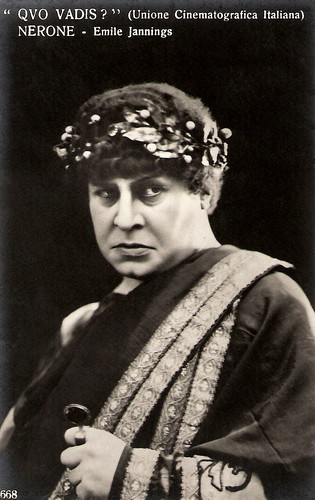
Italian card by editor A. Traldi, Milano. On the back is an ink stamp for the Politeama Cesare Rossi, Fano. Photo: Jannings as the emperor Nero in Quo vadis? (1925, Georg Jacoby, Gabriellino D'Annunzio).
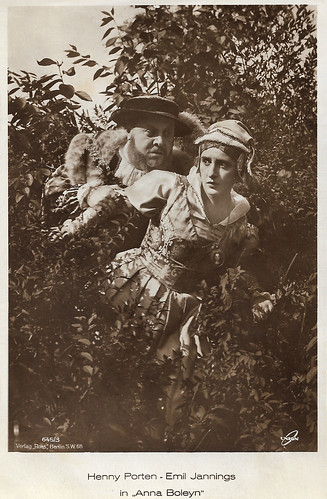
German postcard by Ross Verlag, Berlin, no. 645/3, 1919-1924. Photo: Union Film. Publicity still for Anna Boleyn (1920) with Henny Porten.

German postcard by Ross Verlag, no. 665/2, 1919-1924. Photo: May Film. Publicity still for Tragödie der Liebe/Love Tragedy (1923).
Quo Vadis
The Italo-German coproduction Quo Vadis was shot in Rome with an international cast including Lilian Hall-Davis, Alphons Fryland, Elga Brink, Elena Sangro, Rina de Liguoro, Raimondo Van Riel and Jannings. Producer was grand old man Arturo Ambrosio of the Unione Cinematografica Italiana, an Universal-like merger of many Italian prewar companies. The film had its Roman premiere in March 1925. Quo vadis? tried to equal the earlier version of 1913, adding enormous sets, designed by sculptor Brasini, and streaks of sadism and nudity, but it didn't have the worldwide success of Enrico Guazzoni's earlier version. People were a bit bored with epic films and the censor ordered cuts. The producer almost went bankrupt over copyright claims. It didn't help that the lion tamer Alfred Schneider was convicted because one of his circus lions had killed an extra. But Quo Vadis? is a fascinating film, especially for Jannings's performance of the evil emperor. A few years ago, the film was restored by the EYE Institute in the Netherlands, based on various existing copies. This restored version had its 're-premiere' at the Bologna film festival Cinema Ritrovato in 2002. The user comment on IMDb about the low quality of the film is exaggerated, as well as his note that film historians consider the 1913 version as lost. That version was magnificently restored in 1997 by, again, the EYE Institute and was shown on several international festivals.
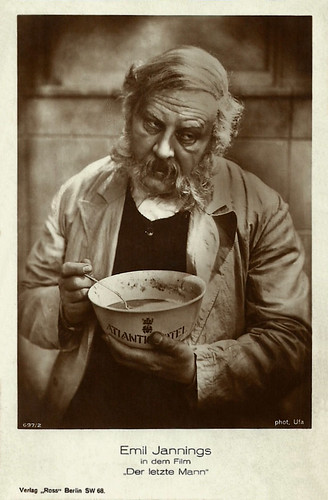
German postcard by Ross Verlag, no. 697/2. Photo: Ufa. Publicity still for Der letzte Mann/The Last Laugh (1924).
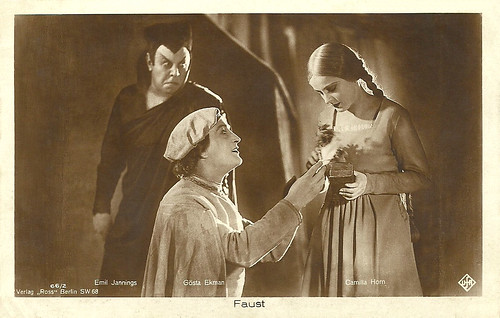
German postcard by Ross Verlag, no. 66/2. Photo: Ufa. Gösta Ekman, Emil Jannings and Camilla Horn in Faust (1926). Collection: Didier Hanson.

German postcard by Ross Verlag, no. 62/2. Photo: Parufamet / Ufa. Still with Emil Jannings as Mephisto and Yvette Guilbert as Marthe in Faust (1926).
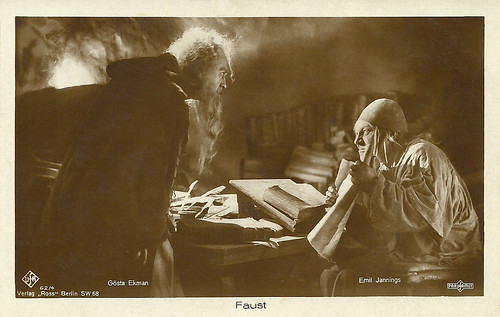
German postcard by Ross Verlag, no. 62/4. Photo: ParUfaMet / Ufa. Gösta Ekman and Emil Jannings in Faust (1926). Collection: Didier Hanson.
F.W. Murnau
Emil Jannings managed to get away from his historical characters with two major films. In Friedrich Wilhelm Murnau's Der letzte Mann/The Last Laugh (1924) he was a proud hotel doorman who loses his self-esteem and the esteem of others when he is reduced to a toilet man, working in the basement of the hotel. In Varieté/Variety (1925, Ewald André Dupont), he is the strong acrobat, who kills his rival out of jealousy. Jannings magnificently expressed the fears and doubts of proud and big-hearted men, who are cheated by their surroundings. Murnau directed him in two more silent classics Tartüff/Tartuffe (1925, Friedrich Wilhelm Murnau) with Lil Dagover, and Faust (1926, Friedrich Wilhelm Murnau) as Mephisto opposite Gösta Ekman as Faust.
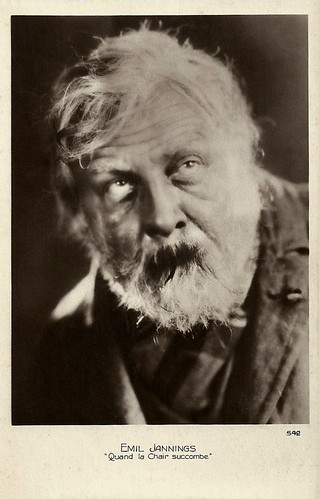
French postcard by Editions Cinémagazine, no. 542. PPhoto"publicity still for Quand la Chair succombe/The Way of All Flesh (1927), now a famous lost film.
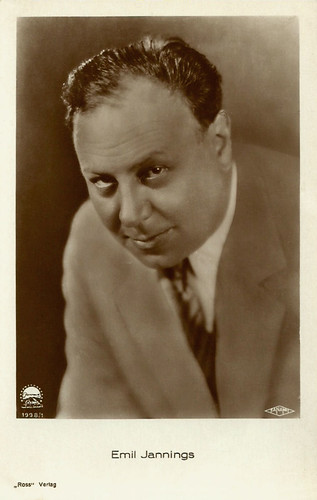
German postcard by Ross Verlag, no. 1998/1, no. 1927-1928. Photo: Paramount / ParUfaMet.
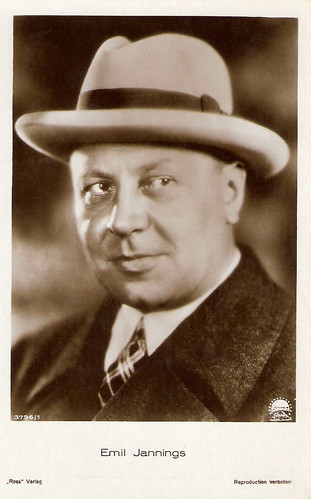
German postcard by Ross Verlag, no. 3796/1, 1928-1929. Photo: Paramount.
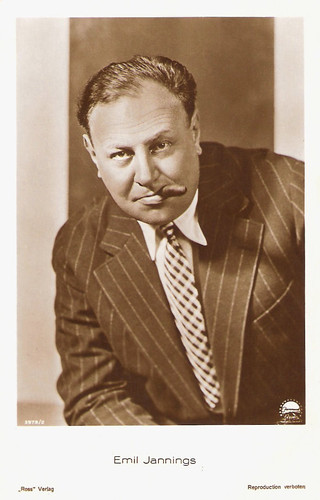
German postcard by Ross Verlag, no. 3979/2, 1928-1929. Photo: Paramount.
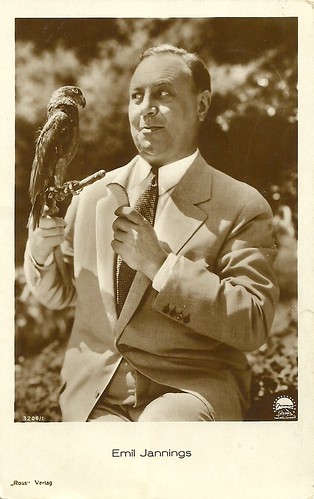
German postcard by Ross Verlag, no. 3206/1, 1928-1929. Photo: Paramount.
Paramount
The success of these films earned Jannings a 3-year contract with Paramount. In Hollywood he played again men who had a social position and then end in misery such as in The Way of All Flesh (1927, Victor Fleming) and in The Last Command (1928, Josef von Sternberg). The two films earned him the first Oscar ever distributed to an actor. Together with Ernst Lubitsch he tried to repeat their German successes in The Patriot (1928, Ernst Lubitsch). When sound came, Jannings left Hollywood and returned to Berlin, where he was launched in his first sound film Der blaue Engel/The Blue Angel (1930), directed by Josef von Sternberg and based on a novel by Heinrich Mann, Professor Unrat. Jannings is the local university professor Immanuel Rath who falls in love with cabaret singer Lola Lola (Marlene Dietrich). Once married to him, she shamelessly exploits and humiliates him. When the film came out, Dietrich's populariy overshadowed Jannings. The film was her ticket to Hollywood. Jannings returned to play on stage, until 1936.

German postcard by Ross Verlag, Foreign, no. 99/1. Photo: Paramount. Publicity still for The Last Command (1928).
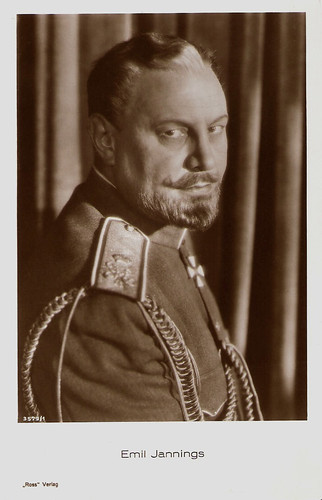
German postcard by Ross Verlag, no. 3579/1, 1928-1929.

German postcard by Ross Verlag, no. 4746/1, 1929-1930. Photo: Ufa. Publicity still for Der blaue Engel/The Blue Angel (1930).
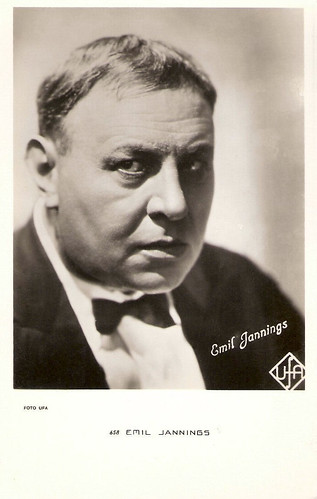
Dutch postcard, no. 658, ca. 1933. Photo: Ufa.

German postcard by Das Programm von Heute, Zeitschrift für Film und Theater G.m.b.H., Berlin. Licensed by Ross Verlag, Berlin. Photo: Terra-Sandau.
Rulers
With his sound films of the early 1930's, Emil Jannings could not compete with his earlier successes. Only after the Nazis came to power, his star rose again. He played rulers, just like in the early 1920's, but this time not the decadent versions anymore. He performed historical characters such as Friedrich Wilhelm I in Der Alte und der junge König/The Making of a King (1935, Hans Steinhoff), Geheimrat Clausen in Der Herrscher/The Ruler (1937, Veit Harlan), the title roles in Robert Koch (1939, Hans Steinhoff) and Ohm Kruger/Uncle Kruger (1941, Hans Steinhoff), and Bismarck in Die Entlassung/The Dismissal (1942, Wolfgang Liebeneiner). All predecessors to Adolph Hitler, to be understood. In 1936 he became board member of Ufa and in 1938 he was chairman there. He was allowed to direct his own films, and thus was the main responsable for Ohm Kruger, one of the most expensive films of the Nazi era. His historical films contributed to the legitimization of the modern politics. In January 1945, he broke up work to the film Wo ist Herr Belling?/Where Is Mr. Belling? (1945, Erich Engel), because of an illness. The film, never finished, was his last work. In 1946, Emil Jannings was denazified and in 1950, he died in Strobl am Wolfgangsee, Austria.
Trailer for Danton (1921). Source: DamienRecords (YouTube).
Scene from Waxworks (1924) with Emil Jannings as the Grand Vizier. Source: SilentFilmDemocracy (YouTube).
Original trailer for Der blaue Engel/The Blue Angel (1930). Source: Eurekaentertainment (YouTube).
1960s Re-release TrailerTrailer for Der blaue Engel/The Blue Angel (1930). Source: Eurekaentertainment (YouTube).
Sources: Filmportal.de and IMDb.

German postcard by Ross Verlag, Foreign, no. 1266/2, 1927-1928. Photo: Alex Binder / Ufa.

German postcard by Ross Verlag, no. 1556/1, 1927-1928. Photo: Alex Binder.

Belgian postcard by Weekblad Cinéma, Antwerpen (Antwerp).

German postcard by Film-Foto-Verlag, no. G 175, 1941-1944. Photo: Star-Foto-Atelier / Tobis.
In the Trenches
Emil Jannings was born Theodor Friedrich Emil Janenz in Rorschach, Switzerland, in 1884. He grew up in Leipzig and Görlitz. He left grammar school prematurely and worked as a ship's mate. In 1900, he started to work at the Görlitz Stadttheater, after which he played in several provincial theaters and with travelling companies. Occasionally he directed plays too. In 1914, he reached Berlin where he was engaged in 1915-1916 at Max Reinhardt's Deutsches Theater. In between, he played on stage elsewhere and had his first film role in the war propagandafilm Im Schützengraben/In the Trenches (1914, Walter Schmidthässler). Until 1920 Jannings continued to play on stage, getting bigger and bigger roles.

German postcard, no. 9904. Photo: Karl Schenker, Berlin.

French postcard by Editions Cinémagazine, no. 205.

Austrian postcard by Iris Verlag, no. 970. Photo: Verleih Philipp & Co.
Ernst Lubitsch
From 1916 on, Emil Jannings played more and more in film, mostly in quickly staged melodramas and crime stories. In 1919 he had his big breakthrough as Louis XV in the lavish period piece Madame DuBarry, directed by his former theater colleague Ernst Lubitsch. The film was such an international hit that former war adversaries such as the United States embraced German cinema. Jannings and his co-star Pola Negri became instant celebrities. For a while he continued to play debauched rulers such as Henry VIII in Anna Boleyn (1920, Ernst Lubitsch), Amenes in Das Weib des Pharao/Pharoah's Wife (1922, Ernst Lubitsch) and Czar Peter the Great in Peter der Grosse (1922, Dimitri Buchowetzki). Other strong historical characters were the title roles in Danton/All for a Woman (1921) and Othello (1922), both directed by Dimitri Buchowetzki.

Italian card by editor A. Traldi, Milano. On the back is an ink stamp for the Politeama Cesare Rossi, Fano. Photo: Jannings as the emperor Nero in Quo vadis? (1925, Georg Jacoby, Gabriellino D'Annunzio).

German postcard by Ross Verlag, Berlin, no. 645/3, 1919-1924. Photo: Union Film. Publicity still for Anna Boleyn (1920) with Henny Porten.

German postcard by Ross Verlag, no. 665/2, 1919-1924. Photo: May Film. Publicity still for Tragödie der Liebe/Love Tragedy (1923).
Quo Vadis
The Italo-German coproduction Quo Vadis was shot in Rome with an international cast including Lilian Hall-Davis, Alphons Fryland, Elga Brink, Elena Sangro, Rina de Liguoro, Raimondo Van Riel and Jannings. Producer was grand old man Arturo Ambrosio of the Unione Cinematografica Italiana, an Universal-like merger of many Italian prewar companies. The film had its Roman premiere in March 1925. Quo vadis? tried to equal the earlier version of 1913, adding enormous sets, designed by sculptor Brasini, and streaks of sadism and nudity, but it didn't have the worldwide success of Enrico Guazzoni's earlier version. People were a bit bored with epic films and the censor ordered cuts. The producer almost went bankrupt over copyright claims. It didn't help that the lion tamer Alfred Schneider was convicted because one of his circus lions had killed an extra. But Quo Vadis? is a fascinating film, especially for Jannings's performance of the evil emperor. A few years ago, the film was restored by the EYE Institute in the Netherlands, based on various existing copies. This restored version had its 're-premiere' at the Bologna film festival Cinema Ritrovato in 2002. The user comment on IMDb about the low quality of the film is exaggerated, as well as his note that film historians consider the 1913 version as lost. That version was magnificently restored in 1997 by, again, the EYE Institute and was shown on several international festivals.

German postcard by Ross Verlag, no. 697/2. Photo: Ufa. Publicity still for Der letzte Mann/The Last Laugh (1924).

German postcard by Ross Verlag, no. 66/2. Photo: Ufa. Gösta Ekman, Emil Jannings and Camilla Horn in Faust (1926). Collection: Didier Hanson.

German postcard by Ross Verlag, no. 62/2. Photo: Parufamet / Ufa. Still with Emil Jannings as Mephisto and Yvette Guilbert as Marthe in Faust (1926).

German postcard by Ross Verlag, no. 62/4. Photo: ParUfaMet / Ufa. Gösta Ekman and Emil Jannings in Faust (1926). Collection: Didier Hanson.
F.W. Murnau
Emil Jannings managed to get away from his historical characters with two major films. In Friedrich Wilhelm Murnau's Der letzte Mann/The Last Laugh (1924) he was a proud hotel doorman who loses his self-esteem and the esteem of others when he is reduced to a toilet man, working in the basement of the hotel. In Varieté/Variety (1925, Ewald André Dupont), he is the strong acrobat, who kills his rival out of jealousy. Jannings magnificently expressed the fears and doubts of proud and big-hearted men, who are cheated by their surroundings. Murnau directed him in two more silent classics Tartüff/Tartuffe (1925, Friedrich Wilhelm Murnau) with Lil Dagover, and Faust (1926, Friedrich Wilhelm Murnau) as Mephisto opposite Gösta Ekman as Faust.

French postcard by Editions Cinémagazine, no. 542. PPhoto"publicity still for Quand la Chair succombe/The Way of All Flesh (1927), now a famous lost film.

German postcard by Ross Verlag, no. 1998/1, no. 1927-1928. Photo: Paramount / ParUfaMet.

German postcard by Ross Verlag, no. 3796/1, 1928-1929. Photo: Paramount.

German postcard by Ross Verlag, no. 3979/2, 1928-1929. Photo: Paramount.

German postcard by Ross Verlag, no. 3206/1, 1928-1929. Photo: Paramount.
Paramount
The success of these films earned Jannings a 3-year contract with Paramount. In Hollywood he played again men who had a social position and then end in misery such as in The Way of All Flesh (1927, Victor Fleming) and in The Last Command (1928, Josef von Sternberg). The two films earned him the first Oscar ever distributed to an actor. Together with Ernst Lubitsch he tried to repeat their German successes in The Patriot (1928, Ernst Lubitsch). When sound came, Jannings left Hollywood and returned to Berlin, where he was launched in his first sound film Der blaue Engel/The Blue Angel (1930), directed by Josef von Sternberg and based on a novel by Heinrich Mann, Professor Unrat. Jannings is the local university professor Immanuel Rath who falls in love with cabaret singer Lola Lola (Marlene Dietrich). Once married to him, she shamelessly exploits and humiliates him. When the film came out, Dietrich's populariy overshadowed Jannings. The film was her ticket to Hollywood. Jannings returned to play on stage, until 1936.

German postcard by Ross Verlag, Foreign, no. 99/1. Photo: Paramount. Publicity still for The Last Command (1928).

German postcard by Ross Verlag, no. 3579/1, 1928-1929.

German postcard by Ross Verlag, no. 4746/1, 1929-1930. Photo: Ufa. Publicity still for Der blaue Engel/The Blue Angel (1930).

Dutch postcard, no. 658, ca. 1933. Photo: Ufa.

German postcard by Das Programm von Heute, Zeitschrift für Film und Theater G.m.b.H., Berlin. Licensed by Ross Verlag, Berlin. Photo: Terra-Sandau.
Rulers
With his sound films of the early 1930's, Emil Jannings could not compete with his earlier successes. Only after the Nazis came to power, his star rose again. He played rulers, just like in the early 1920's, but this time not the decadent versions anymore. He performed historical characters such as Friedrich Wilhelm I in Der Alte und der junge König/The Making of a King (1935, Hans Steinhoff), Geheimrat Clausen in Der Herrscher/The Ruler (1937, Veit Harlan), the title roles in Robert Koch (1939, Hans Steinhoff) and Ohm Kruger/Uncle Kruger (1941, Hans Steinhoff), and Bismarck in Die Entlassung/The Dismissal (1942, Wolfgang Liebeneiner). All predecessors to Adolph Hitler, to be understood. In 1936 he became board member of Ufa and in 1938 he was chairman there. He was allowed to direct his own films, and thus was the main responsable for Ohm Kruger, one of the most expensive films of the Nazi era. His historical films contributed to the legitimization of the modern politics. In January 1945, he broke up work to the film Wo ist Herr Belling?/Where Is Mr. Belling? (1945, Erich Engel), because of an illness. The film, never finished, was his last work. In 1946, Emil Jannings was denazified and in 1950, he died in Strobl am Wolfgangsee, Austria.
Trailer for Danton (1921). Source: DamienRecords (YouTube).
Scene from Waxworks (1924) with Emil Jannings as the Grand Vizier. Source: SilentFilmDemocracy (YouTube).
Original trailer for Der blaue Engel/The Blue Angel (1930). Source: Eurekaentertainment (YouTube).
1960s Re-release TrailerTrailer for Der blaue Engel/The Blue Angel (1930). Source: Eurekaentertainment (YouTube).
Sources: Filmportal.de and IMDb.
No comments:
Post a Comment